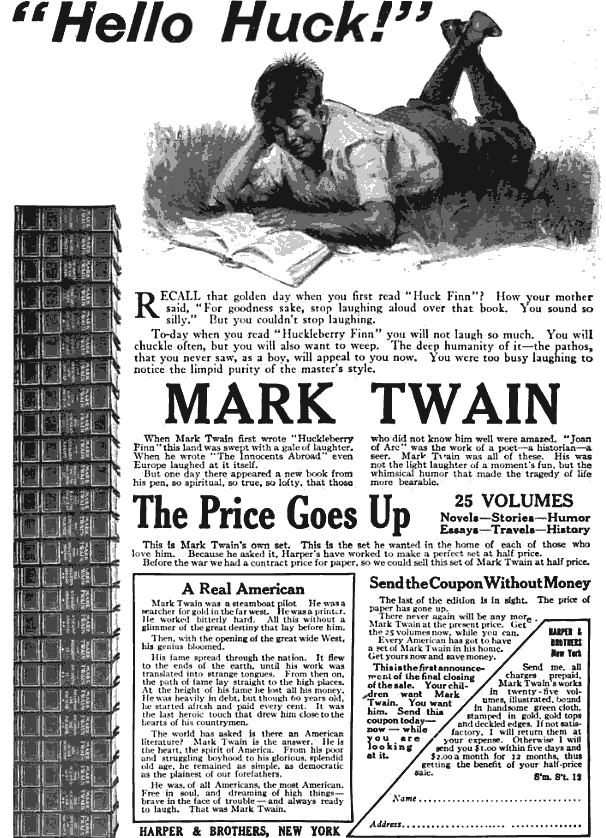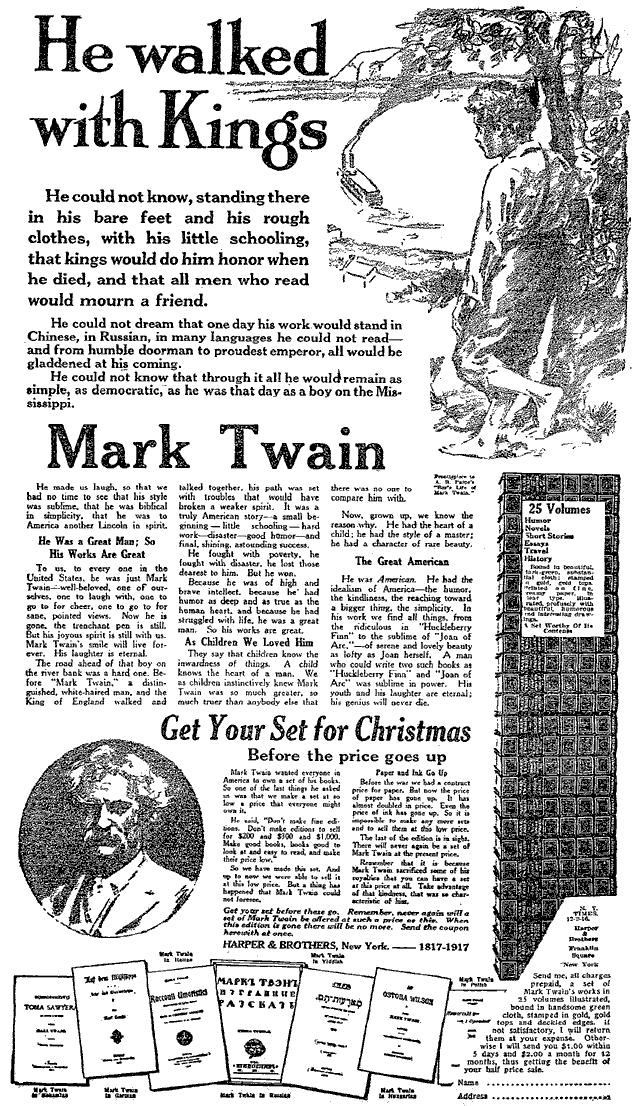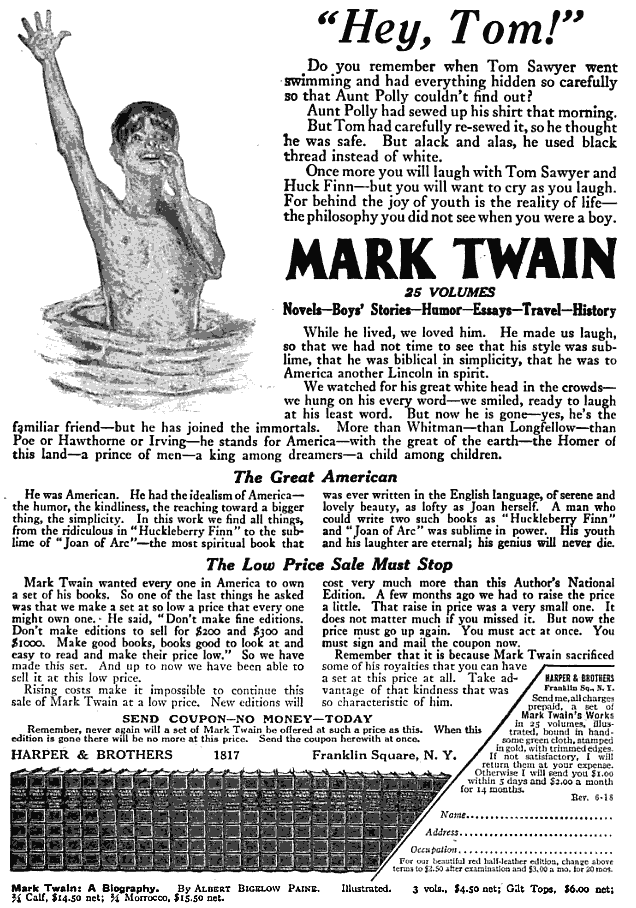SPECIAL FEATURE
by Barbara Schmidt
A History of and Guide to
UNIFORM EDITIONS OF MARK TWAIN'S WORKS
"Advertising people thought that a man had written
the Mark Twain copy. But perhaps only a woman who had no sons could have found
just this particular pleasure in writing these advertisements. Or perhaps
only a girl who had spent a childhood in wishing herself a boy."
- Helen Woodward, 1926
|
Helen Woodward (b. 1882 - d. 1969), one of the earliest and most successful female advertising writers in America, wrote an advertising campaign for the uniform edition of Mark Twain's works for Harper and Brothers. Woodward described herself, "I am a woman, I am a Jew, and I am a radical." (Woodward, 1926). |
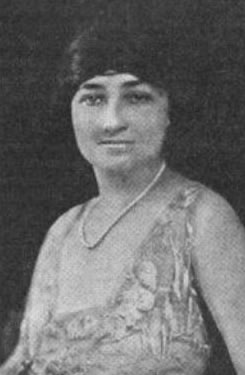 Helen Rosen Woodward |
_____
Chapter 8
Harper and Brothers and the Mark Twain Ads
(1909-1921)
Harvey Out and Brainard In
At the time Samuel Clemens died at sunset on April 21, 1910 twelve different uniform edition sets of his works had been published, including the red cloth Author's National Edition, a $25 set sold through newspapers and magazines on an installment plan. According to George Harvey, Harper and Brothers had paid Clemens and his heirs $314,300 between 1903 and November 1914 (Exman, p. 192). Under Harvey's administration, Harper and Brothers had also undertaken to issue yet another uniform edition of Mark Twain's works in 1915 called the Limp Leather Edition which sold concurrently with the red cloth Author's National Edition 25-volume set. While Harper and Brothers had provided a good income to Clemens with exclusive publishing contracts, Harvey had still been unable to reduce the company's indebtedness to an acceptable level. Harper and Brothers was still heavily in debt to J. P. Morgan. On May 17, 1915 Colonel George Harvey resigned from Harper and Brothers. According to biographer Eugene Exman, "Few publishers have had the Harvey ability for doing most things exceedingly well -- except the sticky and vexatious job of paying off a debt" (Exman, p. 208).
One of the most useful business practices implemented under Harvey's leadership was the establishing of codes for printing plates. The Harper codes which consist of two letters printed on the copyright page of Harper books after 1912 are extremely useful to today's book collectors in determining the age of Harper's editions. While the codes do not indicate the date a book was printed, they do indicate the earliest usage of a particular printing plate.
|
Key to Harper's Printing Codes First letter is month: A= January, B=February, C=March, D=April, E=May, F=June, G=July, H=August, I=September; The list skips J. K=October, L=November, M=December. M=1912; N=1913; O=1914; P=1915; Q=1916; R=1917; S=1918; T=1919; U=1920; V=1921; W=1922; X=1923; Y=1924; Z=1925; A=1926; B=1927; C=1928; D=1929; E=1930; F=1931; G=1932; H=1933; I=1934; K=1935; L=1936 |
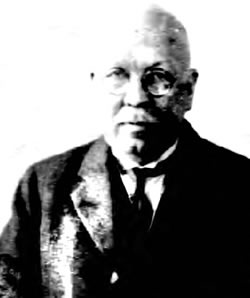 Clinton Tyler Brainard |
After his resignation, George Harvey was replaced by Clinton Tyler Brainard (b. 1865 - d. 1935), an 1890 Harvard graduate. Brainard had held the position of treasurer of Harper and Brothers since 1915. He was promoted to company president and held that position from 1918-1924. |
Brainard had practiced law in Nebraska and Colorado and had been president of the McClure newspaper syndicate as well as a former editor of the Washington Herald. The early part of Brainard's career had been spent in writing advertising copy for Wanamaker's department store and he was later associated with Merrill and Baker, publishers of Ridpath's History of the World which was sold on the installment plan. Brainard had written much of the advertising copy for Ridpath's History of the World. Brainard's chief strength at Harper's was in book merchandising and his considerable knowledge of popular authors and their works, including the subscription set of Mark Twain's works that could be marketed on the installment plan through newspapers and magazines.
Early Career of Helen Rosen Woodward
Helen Rosen Woodward was one of the most successful female writers of advertising copy in the United States. Born into what she later described as "clean, hard, cold poverty" she had struggled to work her way up from stenographer to advertising executive. She, like Brainard, had spent the early part of her career working at Merrill and Baker publishers. She was later employed at Woman's Home Companion and while there was asked to develop an advertising campaign in 1911 for the Review of Reviews, a company that had obtained the rights to publish a 10-volume set of Mathew Brady's Civil War pictures called The Photographic History of the Civil War. The advertising budget for the Brady project was $350,000 and her advertising sold hundreds of thousands of sets on the installment plan.
In 1913 Helen Rosen married William Edward Woodward, a writer and journalist more commonly known as W. E. Woodward. W. E. Woodward had established his own advertising agency and for a time employed the future best selling author Sinclair Lewis as editor at $60 a week. In 1916 Woodward closed his advertising business and accepted a position as promotions manager for Hearst newspapers.
Helen Woodward's next successful advertising project for Review of Reviews was in publicizing a 12-volume uniform edition of O. Henry's works. Rather than tell book buyers they should buy books simply because an author was successful, Woodward believed that an ad should tell buyers what was inside the book and stress content over bindings. According to Woodward, "I tried in my advertising to arouse curiosity first, or love, or fear, or ambition" (Woodward, 1921). Woodward estimated that Review of Reviews spent half a million dollars on one of her ads for the O. Henry edition. With two such successful advertising campaigns to her credit, it is little wonder that Clinton Brainard hired Woodward to advertise the sale of Mark Twain's works on the installment plan.
Woodward's Ad Campaigns for Mark Twain's Uniform Editions
The September 30, 1916 edition of Publishers' Weekly (p. 1113) reported that Harper and Brothers planned to spend an additional $50,000 over a six month period on advertising Mark Twain's works, especially the Author's National Edition. The campaign was to begin with a full page ad in the Saturday Evening Post of October 7, 1916.
In her autobiography Through Many Windows, Woodward summed up her philosophy for writing advertising copy for books sold by mail order:

